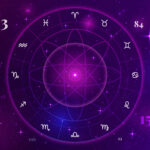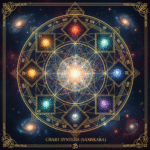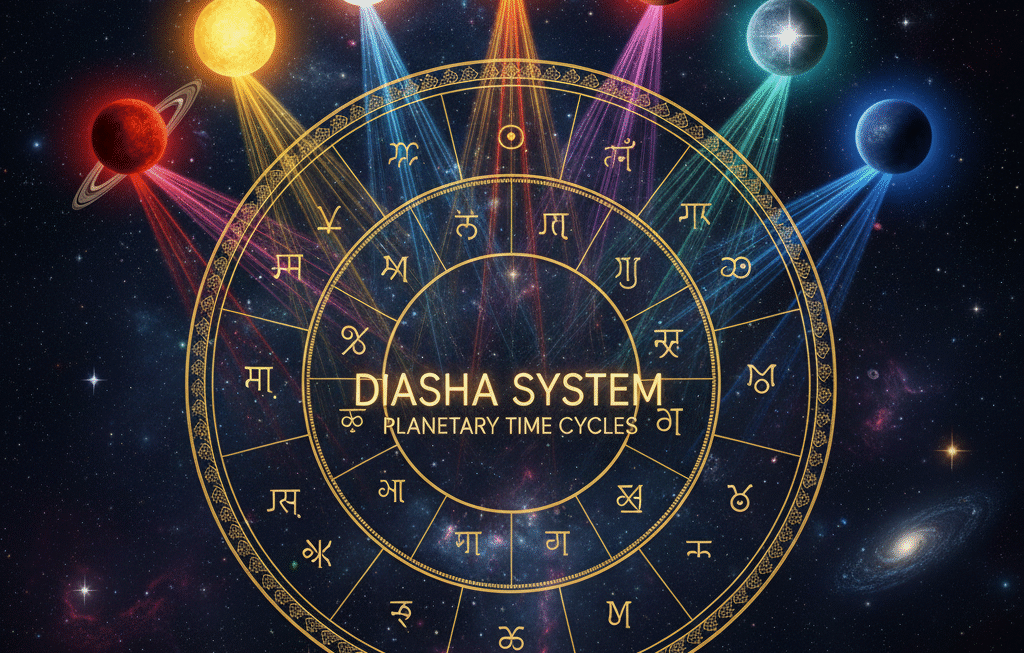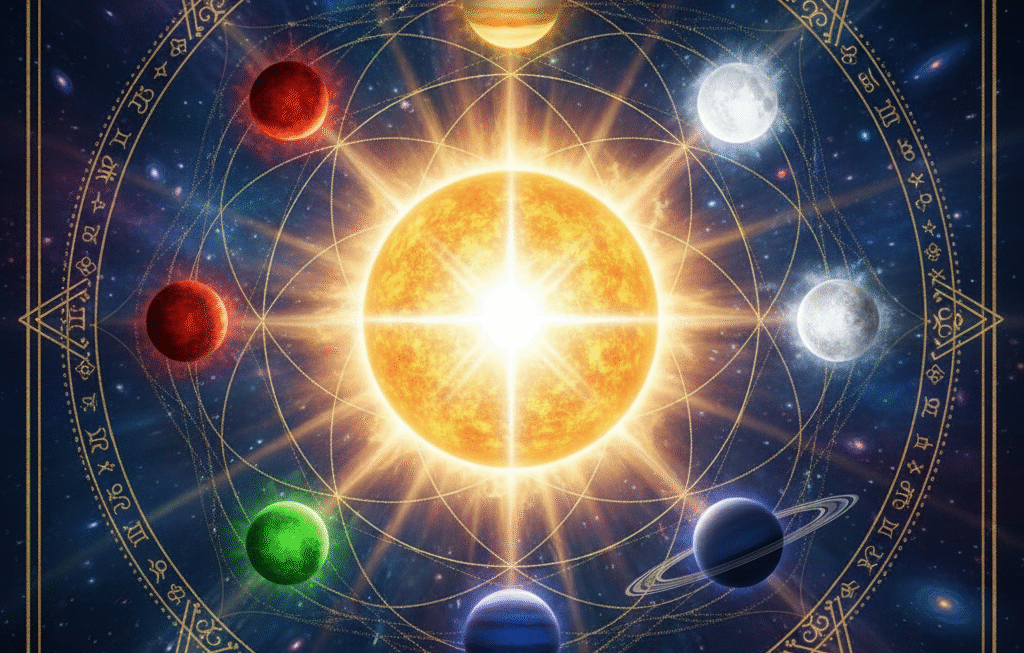You’ve successfully identified your Ascendant (Lagna) and mapped out the 12 houses of your cosmic blueprint. That foundational structure (houses and signs) represents the stage and scenery of your life. Now, it’s time to find the Navagrahas—the nine celestial movers that represent your destiny, energy, and psychological drives.
Knowing how to find planets in kundli is the crucial step that transforms a static chart into a dynamic story. This guide will show you how to accurately locate planets vedic chart in both North and South Indian formats and begin to interpret their significance.
1. The Cast of Characters: Identifying the Nine Planets
Vedic Astrology uses nine key celestial bodies, known as the Navagrahas (“nine graspers” or influences). Before you can find navagrahas, you must recognize their symbols or abbreviations.
| Planet (Graha) | Abbreviation | Primary Influence |
| Sun (Surya) | Su | Soul, Ego, Vitality, Father |
| Moon (Chandra) | Mo | Mind, Emotions, Mother, Nurturing |
| Mars (Mangal) | Ma | Energy, Action, Courage, Sibling |
| Mercury (Budha) | Me | Intellect, Communication, Logic, Trade |
| Jupiter (Guru) | Ju | Wisdom, Fortune, Expansion, Teachers |
| Venus (Shukra) | Ve | Love, Luxury, Relationships, Creativity |
| Saturn (Shani) | Sa | Discipline, Karma, Longevity, Hardship |
| Rahu (North Node) | Ra | Desire, Ambition, Obsession, Materialism |
| Ketu (South Node) | Ke | Detachment, Moksha (Liberation), Spirituality |
- Opinion: These nine planets are the true drivers of karma, shaping your experiences through their placements.
- Reason: Unlike the fixed houses and signs, the planets are constantly moving, and their position at birth shows exactly where your karmic focus lies. Their placement dictates how and where your inner energy is channeled.
- Example: If your core motivation (Sun) is placed in a house of relationships, you will express your ego differently than if the Sun were placed in a house of solitude.
- Opinion/Restatement: Memorizing these abbreviations is essential to efficiently locate planets vedic chart.
2. Locating Planets in the North Indian Chart (Fixed Houses)
In the North Indian (diamond) chart, the houses are fixed. Your task is to identify which of the 12 fixed-position houses contains each planet’s abbreviation.
OREO: Mapping Planetary Positions to Life Areas
- Opinion: The North Indian chart offers a visual advantage for quickly associating a planet with a life area (house).
- Reason: Because the houses never move, you immediately know what life area a planet is impacting. You only need to check the planet’s abbreviation and the number (sign) in that box.
- Example:
- Find the 10th House: This is the fixed, central box on the right side of the chart (representing Career and Public Life).
- Locate the Planets: Look inside that box. Let’s say you see “Sa” (Saturn) and the number 1 (Aries).
- Interpretation: You know Saturn (discipline, delay, hard work) is in your 10th House (Career), and it is operating through the filter of Aries (fiery, pioneering). This immediately suggests a career path built on great effort and responsibility, perhaps with a delayed start, but one that is highly ambitious.
- Opinion/Restatement: To find planets in kundli (North Indian style), simply check the list of planetary positions provided by your chart generator and match the planet’s abbreviation to the fixed house (box) in the diagram.
3. Locating Planets in the South Indian Chart (Fixed Signs)
In the South Indian (square) chart, the signs are fixed in position, and the houses move, starting from your Lagna (1st House).
OREO: Mapping Planetary Positions to Signs
- Opinion: The South Indian chart is visually superior for assessing a planet’s strength (its relationship to the sign it occupies).
- Reason: Since the signs are permanently labeled in each box, you instantly know the sign a planet is placed in, allowing you to gauge its essential nature—whether it is exalted, debilitated, or in its own sign—a crucial step in basic analysis.
- Example:
- Find the Fixed Sign: Locate the box permanently assigned to Capricorn (typically the left-side, third box down).
- Locate the Planets: Look inside the Capricorn box. Let’s say you find “Ma” (Mars) and “Ju” (Jupiter).
- Determine the House: Now, you must remember which house the Capricorn box represents for your chart (by counting clockwise from your Lagna). If Capricorn is your 4th House (Home/Mother), then both Mars and Jupiter are impacting that life area.
- Interpretation: In this specific example, Mars is exalted in Capricorn, meaning it is immensely powerful and positive for the 4th House themes.
- Opinion/Restatement: To locate planets vedic chart (South Indian style), first locate the sign (box) containing the planet’s abbreviation, and second, count the houses (clockwise) from the Lagna to determine where in your life that energy is focused.
4. The Grand Synthesis: Interpretation of Planetary Positions
The act of charting the planetary positions is only the start. The true reading comes from synthesizing the three elements you’ve now mastered:
$$\text{Planet (The Actor)} + \text{Sign (The Costume)} + \text{House (The Stage)} = \text{Karmic Event}$$
- Sun (Actor) in Leo (Costume) in the 10th House (Stage): The core self (Sun) is expressed with confidence and royalty (Leo) in the sphere of career and status (10th House).
- Saturn (Actor) in Pisces (Costume) in the 7th House (Stage): Commitment and delay (Saturn) are expressed with sensitivity and spirituality (Pisces) in the area of relationships and marriage (7th House).
By following these steps, you have successfully moved from a confusing array of symbols to a clear understanding of where your nine cosmic forces are positioned, giving you the power to begin decoding your individual karma.
Conclusion: Bringing the Chart to Life
You have now completed the crucial task of mapping the planetary positions in your birth chart. By locating the Navagrahas, you have found the nine active energies that shape your life’s events, desires, challenges, and strengths.
- You know the three cardinal points: the permanent identity of the Lagna (Ascendant), the fixed structure of the 12 Houses (life areas), and the dynamic placement of the Planets (Grahas).
The journey of reading a birth chart is one of synthesis. Do not look at Saturn in isolation, but look at the entire combination: Saturn in a specific sign, in a specific house. That combination is your specific karma.
Congratulations on moving from the basic structure to the dynamic forces within your Kundli! Keep practicing these steps with your own chart, and the complex web of lines and symbols will gradually transform into a clear, insightful narrative of your destiny.











